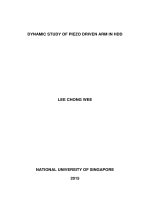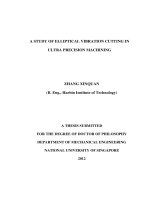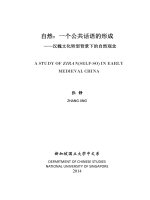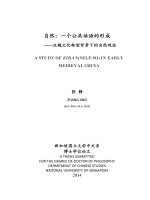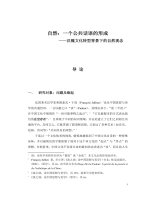Study of the morphological and functional alterations of high endothelial venules in the regional lymph nodes to tongue cancer patients and its clinico pathological correlations
Bạn đang xem bản rút gọn của tài liệu. Xem và tải ngay bản đầy đủ của tài liệu tại đây (2.77 MB, 130 trang )
STUDY OF THE MORPHOLOGICAL AND FUNCTIONAL ALTERATIONS OF HIGH
ENDOTHELIAL VENULES IN THE REGIONAL LYMPH NODES OF TONGUE
CANCER PATIENTS AND ITS CLINICO-PATHOLOGICAL CORRELATIONS
LEE SER YEE
( M.B.B.S, M.R.C.S (Ed), M.MED (SURGERY), F.R.C.S(Ed), F.A.M.S )
A THESIS SUBMITTED
FOR THE DEGREE OF MASTER OF SCIENCE
SCHOOL OF MEDICINE
NATIONAL UNIVERSITY OF SINGAPORE
2010
Acknowledgements
I would like to express my thanks and gratitude to both my Supervisor and Mentor, Professor
Soo Khee Chee, Director of National Cancer Centre, Singapore (NCCS) for his guidance,
innovation and inspiring spirit for research and thirst for knowledge. Professor Soo‟s ideas and
vision helped and guided me through from the beginning of a simple question to formation of a
hypothesis to a research plan and detailed study protocol. As a clinician, my endeavor in science
and laboratory work would not be possible without the guidance and support of Professor Soo.
His expert advice, experience and constructive criticism were pivotal in all the phases of my
study and were critical in the completion of this study.
I would also like to express special thanks to Dr. Chao-Nan Qian, Deputy Director of Sun Yatsen University Cancer Center, China and Deputy Director of VARI-NCCS Translational Cancer
Research Laboratory for his innovative idea and his knowledge in this field, he guided me and
taught me many aspects in the process of pursuing scientific knowledge. I am also deeply
indebted to Dr. Ooi Aik Seng, scientist from the Laboratory of Cancer Genetics, Van Andel
Research Institute, Grand Rapids, Michigan, USA. He taught me many laboratory techniques and
skills essential for this study.
I would like to thank Ms Chen Peiyi from the Department of Statistics and Applied Probability,
National University of Singapore for her expertise and guidance in the statistical analysis of my
results.
i
I am also grateful to all the laboratory staff from the VARI-NCCS Translational Cancer Research
Laboratory and the Laboratory of Cancer Genetics, Van Andel Research Institute, Grand Rapids,
Michigan, USA for their assistance and for making the hours in the laboratory so enjoyable and
educational.
I wish to express my appreciation to Associate Professor Wong Wai Keong, Head of the
Department of General Surgery, Singapore General Hospital and Associate Professor Koong
Heng Nung, Head of the Department of Surgical Oncology, National Cancer Centre, Singapore
as well as all my fellow colleagues and seniors at both departments for their support and
understanding in order for me to have time to complete my study.
Dr. Lee Ser Yee
2011
ii
Title:
RETROSPECTIVE
STUDY
OF
THE
MORPHOLOGICAL
AND
FUNCTIONAL ALTERATIONS OF HIGH ENDOTHELIAL VENULES IN
THE REGIONAL LYMPH NODES OF TONGUE CANCER PATIENTS
AND ITS CLINICO-PATHOLOGICAL CORRELATIONS
Table of Contents
Page
1. Summary
v
2. List of Tables
vi-xi
3. List of Figures
xii-xxi
4. List of Illustrations
xxii-xxv
5. Introduction and Background
1
6. Squamous Cell Carcinoma of the Tongue
3
a. Epidemiology
3
b. Clinical and pathological features
4
c. Current opinions on management and therapy
7
i. Role of Neck Dissection in surgical management of tongue cancer 16
ii. Role of Sentinel Lymph node biopsy
20
d. Controversies and issues regarding treatment options
24
7. Pathogenesis
of
Lymph
Node
Metastasis,
Lymphangiogenesis
8. High Endothelial Venules (HEV)
a. Morphological features and functions
Emphases
on
Angiogenesis
and
27
32
32
iii
Table of Contents
b. HEV and its markers
c.
HEV‟s role in immunology and cancer
Page
33
33
9. Aim and Hypothesis of the Study
36
10. Patients, Materials and Methods
37
a. Patients
37
b. Immunohistochemistry
38
c. Computer- assisted Image analysis
39
d. Statistical analysis
40
11. Results
41
a. Summary
42
b. Main results in details
44
c. Supplementary data Analysis Results
69
12. Conclusion
81
13. Discussion
82
14. Future Directions
91
15. Limitations
92
16. Bibliography
95
iv
1. Summary
Squamous cell carcinoma of the tongue is one of the most prevalent tumors of the head and neck
region. The extent of lymph node metastasis is a major determinant for the staging, the most
reliable adverse factor for prognosis of squamous cell carcinoma of the tongue and it guides
therapeutic decisions. The Paget‟s “Seed and Soil” theory for cancer and its metastasis is well
known and established. Angiogenesis and lymphangiogenesis are both important processes
contributing to tumor progression and metastasis. Cancer research has been driven to understand
tumor-induced angiogenesis and lymphangiogenesis. Primary tumors can induce lymph channel
and vasculature reorganizations within sentinel lymph nodes before the arrival of cancer cells.
The key blood vessels in such lymph nodes that are remodeled are identified as high endothelial
venules (HEV). The morphological alteration of HEV in the presence of a cancer, coupled with
the increased proliferation rate of the endothelial cells, results in a functional shifting of HEV
from immune response mediator to blood-flow carrier. Previous studies have demonstrated the
role of HEV in inflammatory setting. It was demonstrated that a cancer-induced reorganization is
quite different from an endotoxin-induced inflammatory alteration. Our preliminary studies of
HEV and its role in lymph nodes of patients with squamous cell carcinoma of the tongue with
clinico-pathological correlations revealed a relationship between HEV, cancer metastasis and
clinical outcome. These pathological processes are reviewed and clinical phenomena explained
in the aid of developing novel therapeutics and prevention strategies against cancer metastasis in
the future.
v
2. List of Tables
1. Table 1: AJCC Tongue Cancer TNM Staging System
2. Table 2: Adverse features of tongue SCC
3. Table 3: Summary of results
4. Table 4: Summary of the secondary analysis
vi
Table 1
American Joint Committee on Cancer Staging for Tongue cancer
_____________________________________________________________________________
vii
Table 2 Adverse features of tongue SCC
Adverse features of Tongue Cancer
1.
Extracapsular nodal spread (ECS)
2.
Positive margins
3.
pT3 or pT4 primary
4.
N2 or N3 nodal disease
5.
Nodal disease in Levels IV or V
6.
Perineural invasion
7.
Vascular embolism
viii
Table 3: Immunohistochemistry Protocol
Steps
1
2
3
4
5
6
7
8
9
10
11
12
Process
Deparaffinization
Antigen Retrieval
Rinse with Phosphate Buffered Saline(PBS) briefly
Add 3% Hydrogen Peroxide- incubate
Wash with PBS
Add Horse Serum (blocking serum)- incubate
Add Primary antibody (anti-MECA 79), incubate overnight
Wash with PBS and put on belly dancer
Add Biotinylated secondary antibody
Wash with PBS and put on belly dancer
Add Streptavidin/peroxidase- incubate
Wash with PBST X 2 times
(5 mins each time)
13 Wash with Antibody Dilution Buffer (PBE) 3 times
(3 mins each time)
14 Add Novo Red- develop for 10 mins
15 Counter stain IHC
Time
20 mins
2 mins
15 mins
5 mins
15 mins
12 hours
5 mins
10 mins
5 mins
5 mins
10 mins
9 mins
10 mins
ix
Table 4 Summary of results
x
Table 5
Summary of the secondary analysis in the supplementary data
Tumor Characteristics
Clinical data
Relative
Risk
p
Tumor volume (TV)
Overall Survival
0.985
0.476
Disease Free Interval
0.990
0.481
Overall Survival
1.116
0.71
Disease Free Interval
1.302
0.348
Overall Survival
0.882
0.815
Disease Free Interval
1.436
0.308
Stage (S)
Grade(G)
Since there are no statistical difference noted between the 2 groups, we now consider the
2 groups (Cases and Controls) as a cohort and repeat the analysis summarized below
(i.e. without considering the group )
Tumor volume (TVc)
Stage (Sc)
Grade(Gc)
Overall Survival
0.994
0.765
Disease Free Interval
0.994
0.648
Overall Survival
1.364
0.327
Disease Free Interval
1.209
0.255
Overall Survival
1.121
0.822
Disease Free Interval
1.493
0.221
xi
3. List of Figures
1. Figure 1: National Comprehensive Cancer Network (NCCN) recommendations for
tongue cancer
2. Figure 2: NCCN treatment guidelines for unresectable tumors
3. Figure 3: Systemic Therapy and Radiotherapy according to the NCCN guidelines
4. Figure 4: Kaplan Meier Overall Survival curves for the two groups (Cases vs. Controls)
5. Figure 5: Disease free interval curves for the two groups (Cases vs. Controls)
6. Figure 6: Dilated HEVs with red blood cells in its lumen (high power field)
7. Figure 7: Metamorphosis of HEVs in a tumor microenvironment
8. Figure 8: Overall survival relative risk with respect to the different HEVs ratios
9. Figure 9: HEV was remodeled from a thick-walled, endothelial vessel with a small lumen
to a thin walled, large-lumen vessel
xii
Figure 1
xiii
Figure 2
xiv
Figure 3
Systemic Therapy and Radiotherapy according to the NCCN guidelines
xv
Figure 4
Kaplan Meier Overall Survival curves for the two groups (Cases vs. Controls)
p-value = 0.066
xvi
Figure 5
Disease free interval curves for the two groups (Cases vs. Controls)
xvii
Figure 6
Dilated HEVs with red blood cells in its lumen (high power field)
Green arrows point to the dilated HEVs with red blood cells in its lumen in the lymph node
xviii
Figure 7
Metamorphosis of HEVs in a tumor microenvironment.
This process begins with the HEV increasing in absolute numbers, then each of them becoming
more dilated and lastly every one of them will become a function vessel carrying blood.
Transformation of HEVs
Normal HEVs (A)
Normal
Dilated HEVs (B)
Dilated HEVs with rbcs
within its lumen (C)
Abnormal
IHC with Meca-79 Antibody in High Power Field
xix
Figure 8
Overall survival Relative Risk
Overall survival relative risk with respect to the different HEVs ratios
20
15
10
5
0
B/A
Overall survival
1.078
Relative Risk
C/A
C/B
3.624
17.884
no. of all HEVs : A
no. of dilated HEVs (defined as lumen size more than 80square micron) : B
no. of dilated HEVs with red blood cells (rbcs) inside its lumen : C
Percentage of dilated HEVs with respect to total no. of HEVs i.e. Ratio of dilated HEVs
to the total number of HEVs : B/A
Percentage of dilated HEVs with rbcs within its lumen with respect to total no. of dilated
all HEVs i.e. Ratio of dilated HEVs with rbcs within its lumen to total no. of dilated
HEVs : C/B
Percentage of dilated HEVs with rbcs within its lumen with respect to total no. HEVs :
C/A
xx
Figure 9
HEV was remodeled from a thick-walled, endothelial vessel with a small lumen to a thin walled,
large-lumen vessel
xxi
4. List of Illustrations
1. Illustration 1: Cervical lymph node anatomical levels
2. Illustration 2: Morphology of HEVs
3. Illustration 3: Venn diagram illustrating the relationship between the different HEV
parameters (A, B, C).
xxii
Illustration 1
xxiii



